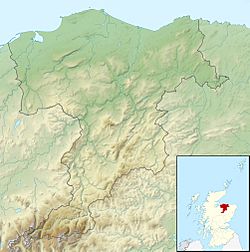Thomshill facts for kids
Quick facts for kids Thomshill |
|
|---|---|
| Alternative name(s) | The Foths |
| Type | Quingenary fort (possible) |
| Location | |
| Coordinates | 57°35′59″N 3°19′21″W / 57.5996°N 3.3224°W |
| Site notes | |
| Condition | Cropmarks |
| Excavation dates | 1982–1990 |
Thomshill is a special place in Scotland, about 6 kilometers (4 miles) south of Elgin. It's where archaeologists found what might have been an old Roman military camp or fort. This camp was a rectangular area, like a big fenced-off space. It covered about 3.25 hectares (8 acres) and was built on a hill about 72 meters (236 feet) high.
Thomshill is one of several places in Scotland that might have been Roman forts. These sites, including Boyndie, Balnageith, Easter Galcantray, and Tarradale, suggest that the Roman Army, led by Agricola, might have stayed in the Moray area after a big battle called the Battle of Mons Graupius in the year 84 AD.
Contents
Finding and Exploring Thomshill
How Was Thomshill Discovered?
People first wrote about Thomshill in 1834. They described "rectangular trenches" at a place called The Foths, saying they might be a Roman castra (which means a Roman camp). In 1871, mapmakers from the Ordnance Survey also noted these trenches, but said they were almost gone because of farming. By 1971, you couldn't see any signs of the camp on the ground.
Archaeologists Start Digging
In the 1980s, archaeologists used special tools like aerial photography (taking pictures from the sky) to look for hidden signs. They found "cropmarks," which are patterns in crops that show where old structures are buried. These cropmarks showed three sides of a rectangular area with ditches. This area was on a small hill overlooking a dry river valley.
Archaeologists began digging in September 1982. They continued to dig between 1985 and 1990, making 44 trenches. These trenches helped them explore the ditches, the inside of the camp, and other interesting features nearby.
What Did They Find?
The excavations showed that the camp's main ditch was V-shaped. It had a special "sump" or cleaning slot at the bottom. They also found clear signs of a turf revetment (a strong wall made of earth and grass) on the inside edge of the ditch. This ditch was up to 5 meters (16 feet) wide!
The corners of the camp were rounded, not sharp. Archaeologists also found a series of post-holes (holes where wooden posts once stood) near the inside edge of the southern side of the camp. They even found two smaller ditches that were older than the main camp. These older ditches suggest that people might have lived or worked on this site even before the Roman camp was built.


